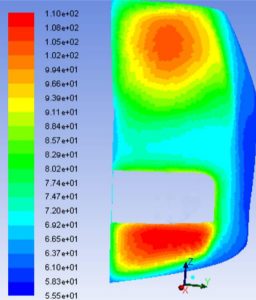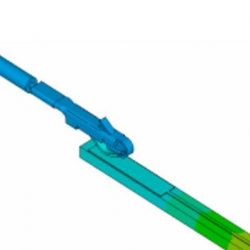Thermal simulation or thermal calculation enables the representation of heat developments and heat distributions within your assembly in interaction with adjacent individual components. By means of thermoelectric simulation, we depict the heat development through current flow within components and assemblies. Thus, for example, a statement can be made as to whether adjacent components are destroyed or damaged if an adjacent component overheats. Furthermore we are able to determine duration and temperature distribution during a cooling or heating process by transient thermodynamic simulation.
Often a thermal calculation in combination with supplementary temperature measurements is used in the Product development process not only to ensure function and product quality, but also to validate the arrangement of thermally sensitive components.
Thermodynamics simulation is used to model temperature distributions in components (solids) by effects such as convection, heat conduction and thermal radiation.

Thermal simulation of a rear light
Temperature distributions due to the action of currents are usually given more by CFD simulations but we are also happy to help you with our range of services. Avoid component failure and play it safe with our support !
State of the art for determining the temperature distribution by thermal simulation
The thermodynamics simulation is essentially based on the theory of FEM calculation. In contrast to structural analysis, however, the algorithms here are far less complex. Thus, even complex assemblies with many thermal contacts can be realistically simulated without any problems.
Procedure for the functional validation of your products through thermal simulation
When it comes to securing the functionality of your design by thermodynamics simulation, we take a close look at the temperature distribution within your product.
On request, we contact the manufacturers of the individual components to determine the corresponding requirements and thermal limit values. This enables us to specifically design your construction with our heat simulation. In this way we implement the corresponding manufacturer information regarding your sensitive components together with your specifications for heat sources and sinks in contact and boundary conditions that are as realistic as possible.
Determination of characteristic values for thermal simulation and thermoelectric simulation

Thermoelectric simulation of a printed circuit board
For thermodynamic simulation and thermoelectric simulation, heat capacities, thermal conductivities, densities, voltages and currents are usually decisive as characteristic quantities. They describe the thermal or thermoelectric properties of the individual materials, or characterize the behavior of the thermodynamics simulation in the contact areas by defining thermal contacts.
These characteristic values are usually specified by the customer, but can be determined by us on request, approximated by interpolation methods or determined by tests.
Failure criteria for the evaluation of the thermodynamics simulation
For a failure assessment within the framework of the thermal simulation, we map the thermal loads on your system as realistically as possible. Together with you, we determine the necessary criteria for the failure of your components. Usual failure criteria are included:
- Exceeding a maximum temperature at a certain component
- Emergence of hotspots due to insufficient heat dissipation
other topics on thermal simulation: